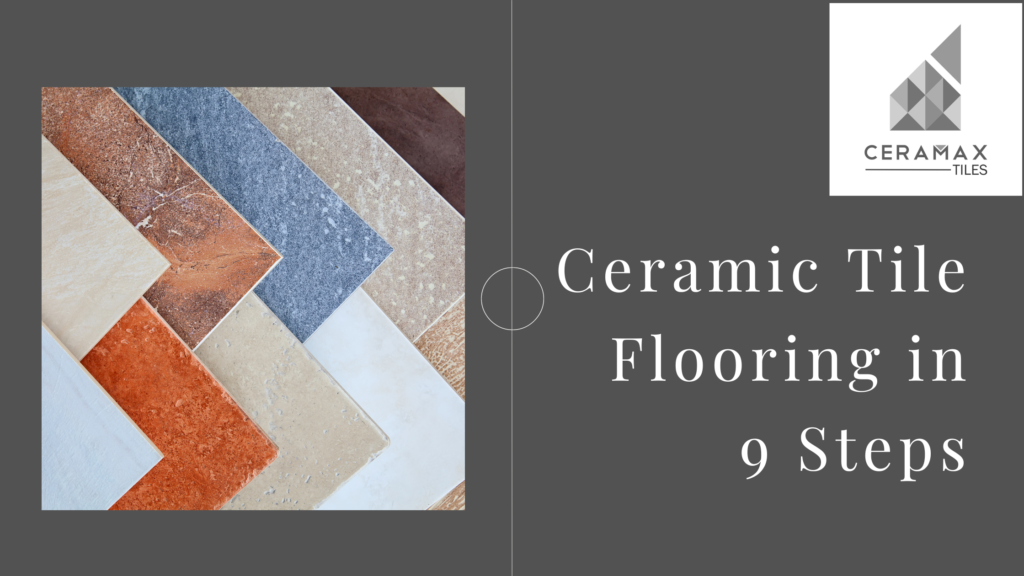Ceramic Tile Flooring in 9 Steps
Here are simple installation tips on bathroom flooring and floor tile that’ll keep what’s underneath your feet solid and long-lasting.
Steps on How to Lay Tile
1. Tiling a Floor Overview
- Strive for a layout that maximizes the number of whole tiles and the size of any cut tiles.
- When awkwardly sized tiles can’t be avoided, place them where vanities will cover them later or out of the main sight lines from the doorway.
- You shouldn’t step on any tiles until the thin set has cured for at least 24 hours.
- Save all of the cuts requiring a wet saw for last. Then rent the wet saw for one day.
2. Dry layout
- Find the midpoint of each wall and snap chalk lines on the floor. The line crossing at the room’s centre is the starting point of the tile.
- Lay a row of tiles along a straightedge more than halfway across the room. For consistent joints, use tile spacers. This row determines the size of cut tiles along the walls.
- At the room’s centre, place a tile where the chalk lines cross with its edges touching the lines. Measure from one wall (call it A) to the nearest tile edge. Now, go to the tile row and, starting at a joint, measure along the row and mark the distance you just measured. The mark shows the width of the tile at the wall. If that measurement is less than 2 inches, go back to the centre tile and move it away from wall A to create a wider cut tile.
3. Dry layout, Part II
- From the center tile, measure to the opposite wall (call it B; mark this distance along the tile row. Adjust the center tile along the A-to-B line until measurements at walls A and B are the same.
- After adjusting the A-to-B line, mark the center tile where it touches the chalk line between the other walls (call them C and D). Align these marks with the C-to-D chalk line. Repeat the measuring and adjusting process for walls C and D.
- Lay a straightedge parallel to the C-to-D line and against one side of the center tile. Mark the straightedge where it meets a corner of the tile. This mark is your starting point for laying tile.
- Trim door casings with a flush-cut saw so tile can slip underneath. Cut with saw held flat against a tile on top of a piece of cardboard (to represent the thickness of the thinset).
4. Spread thin-set mortar
- Chuck a mixer into a drill and blend the powdered thinset with latex additive—not water—until it’s the consistency of mayonnaise. Let it slake (rest) for about 10 minutes. Mix only as much thinset as you can use in 2 hours.
- With the flat edge of a trowel, spread a thin layer of thinset (scratch coat) over a 2-by-3-foot area next to the straightedge.
- Before the scratch coat dries, apply more thinset using the notched edge of the trowel. Hold the trowel at a 45-degree angle to the floor and spread the thinset evenly in broad curved strokes, then finish with a straight pass, which ensures the best adhesion. Combing the thinset into furrows allows air to escape as the tile is set.
Tip: When spreading thinset, press down hard so that the trowel makes a scraping sound; the trowel’s notch size should equal the tile thickness.
5. Set the tile
- Gently lay a tile on thinset next to the straightedge. With fingertips widespread, push down with a slight twist of the wrist.
- Use this same technique to set each tile, making one row along the straightedge. Using tile spacers ensures even joints.
- Move the straightedge out of the way and lay the next row alongside the first, using the edge of the tile as your guide. Continue spreading thinset and setting tiles in 2-by-3-foot sections, working from the center of the room out toward the walls. Every few rows, hold a framing square or A-square alongside the edge of the tiles to check that they are square to each other.
Tip: Consistent finger pressure (and constant practice) helps avoid lippage—where a tile’s edge is higher or lower than its neighbors.
6. Final cuts
- Make straight cuts as needed with a snap cutter. When waste is more than an inch wide, score tile with one firm stroke, then break by pushing down handle. Smooth cut edge with rubbing stone.
- For straight cuts with waste less than an inch wide, score tile on snap cutter, then snap pieces off with nibblers or use a wet saw.
- To fit a tile around an outside corner, hold one edge against the wall and mark the tile where it touches the corner. Pencil a line all the way across the tile. Then, without turning the tile, move it to the other side of the corner and again mark where tile and corner meet. Mark an X on the part to be cut away.
7. Notch the tile
- On a wet saw, cut the tile from the mark to the line, taking care not to go beyond the line. Then turn the tile and cut along the line next to the X, up to but not beyond the first cut. At end of cut, lift up the edge farthest from you to help free the waste.
- For curved or scribed cuts, make parallel slices with the wet saw into the waste section, up to but not past the line marking the cut. Then break away the remaining “fingers” with nibblers.
8. Fill the tile joints with grout
- After tile sets overnight, use a margin trowel to scrape off any thinset from the tile surface or in the joints.
- Mix up a batch of grout to a looser-than-mayonnaise consistency. Add water a little at a time by squeezing it from a sponge.
- Scoop a trowelful of grout onto the floor and spread it with a rubber float held at a 45-degree angle to the floor. Push grout into the joints by first moving the float in line with the joints, then diagonal to them. Work from the edges of the room toward the center.
9. Cleaning up the grout
- Allow the grout to set up for 20 or 30 minutes. It should be firm to the touch before you begin washing the tile’s surface. Wipe away grout haze with a damp, well-squeezed sponge rinsed often in a bucket of clean water.
- Again, wait for grout to haze over, then wipe with clean sponge. Repeat until the tile is clean.
Tip: Don’t be too aggressive when wiping up grout haze, or you could pull grout out of the joints.





